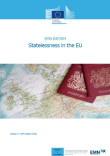Statelessness in the EU (EMN Inform)
This EMN Inform examines – inter alia – the state of play of the 1954 and 1961 conventions on statelessness, statelessness determination procedures, rights granted to recognized stateless persons, and the situation of stateless minors in the EU.

Download publication
Background information
Statelessness is a legal anomaly, which can prevent the persons concerned from accessing fundamental human, civil, political, economic, social and cultural rights (e.g. difficulty to enroll in education programs, acquire property, marry, etc.). The main causes of statelessness include - among others - state succession, ill-defined or discriminatory nationality laws, displacement and forced migration or birth to a stateless person.
In Europe, UNHCR estimates the total number of stateless persons in 2015 at 592,151 individuals.
This EMN Inform is the synthesis of the answers provided by Member States and Norway to three ad-hoc queries launched in the framework of EMN. The Inform examines – inter alia – the state of play of the 1954 and 1961 conventions on statelessness, statelessness determination procedures, rights granted to recognized stateless persons, and the situation of stateless minors.
Inform: some findings
- There is no homogeneity among Member States as regards the procedures they use to determine statelessness.
- In the majority of Member States there is no direct link between the determination of statelessness and the issuing of a specific residence permit. So, in principle, the individual who has been recognized as stateless, does not have an automatic right to stay in the country that carried out the statelessness determination.
- Access to the labour market, education and training as well as health care and social aid does not depend on the determination of statelessness but on the residence permit that the stateless person can obtain.
- Most Member States facilitate to a certain extent access to nationality for children born stateless in their territory.
- There is no specific determination procedure for stateless unaccompanied minors that would take account of the specific vulnerability of this group. Nevertheless, in most cases a guardian is appointed to accompany the minor.
- In 13 Member States access to citizenship is simplified for stateless persons. Eight Member States do not foresee simplified access to nationality for stateless persons.
Please find additional information in the attached Inform.